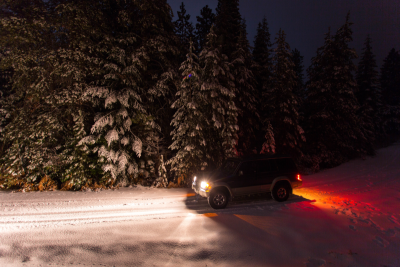It’s that time of year when you’re checking weather conditions and school closings like it’s your social media feed. When bad weather hits and road conditions are messy, it’s always best to stay off the roads if you can. But we understand not everyone can do that and sometimes the weather can turn bad suddenly when you are already out. So, here are some winter weather driving tips to help keep you safe on the roads.
Slow and Steady
Going slowly to maintain traction is key! Start slow and stop slow. When you hit the brakes or try to start driving again after you stop, your tires might struggle to gain that traction back again and your car could slide. If it's possible, try to keep your driving smooth, avoiding frequent stops and starts. You will get the best traction when you are going at a consistent speed that is not too fast.

Tire Treads and Pressure
Winter driving and worn-down tires are a bad mix! A key factor in driving in the snow is having good traction with your tires. When your tires start to wear down, they become smoother and the tire tread does not have as much ability to grip the road when driving in the snow. Depending on where you live and the type of snow conditions you experience, tire chains may be helpful in areas that experience frequent heavy snowfall most of the winter season. Some state laws, however, do not permit the use of tire chains except during specific times of the year so be sure and check to find out what is permitted in your state.
Check your tire pressure often in the winter. It's common for tire pressure to drop in cold weather. Low tire pressure can be dangerous, so keep your tires at the recommended pressure. If you don't know the recommended pressure for your vehicle, you can find it on a sticker inside the driver’s door.1 Look for the recommended PSI (pounds per square inch). For example, if you see that your vehicle recommends 33 PSI, you have enough air in your tire when the tire pressure gauge reads 33 PSI.

If You Get Stranded
If your car slides off the road, you run out of gas, your car breaks down or any other reason that might leave you to be stranded during winter weather, you need to call for help from a roadside assistance service or someone you know who can come get you. Here are some tips to keep you safe until help arrives:
Have some kind of brightly colored material you can tie to your antenna or a bright colored cloth you can put over a window. As snow falls, it might be hard for someone to see your vehicle. The bight colored material will help someone find you.
You can also turn an interior light on. The interior light will not use as much battery as headlights and can also help someone find you if you are stranded.
As you turn your car on and off to keep you warm while you wait, make sure your exhaust pipe is not blocked by snow, ice or any other object. A blocked exhaust could cause carbon monoxide to come into the vehicle.
Having an emergency supply kit in your car can be especially helpful in the winter. Your emergency supply kit should have nonperishable food such as granola bars or snack foods, water, a first-aid kit and a blanket. It's also a good idea to have a phone charger bank so you can keep in contact with someone to help you.
Be Prepared
During winter months and inclement weather, you may experience situations you don’t have to worry about the rest of the year. Here are a few tips to help you be prepared:
Keep your gas tank filled up more frequently. You never know when winter weather could cause a traffic standstill. If you get stuck in traffic and run out of gas on a snowy road during inclement weather, it might be even more difficult for someone to get to you and help you get fuel in your car. This could result in being stranded with no heat. So, if you normally wait until your fuel meter drops to the verge of empty, the winter months are a great time to break that cycle and fill back up when your gas tank hits the halfway line.
Check your antifreeze levels. Antifreeze is important all year long as it keeps your engine cool in hot temperatures and keeps your engine from freezing in cold temperatures. As the degrees start dropping, make sure you check the antifreeze level to help avoid damaging your engine or getting stranded.
Start your winter season with new windshield wiper blades. It's recommended that you change your wiper blades every 6 - 12 months.2 What better time than the start of winter weather! If your windshield wipers are streaking or leaving behind patches, that can make driving difficult and dangerous especially when it's snowing or sleeting.
With these winter weather tips, we strive to help you be safe and feel a little more prepared for the unexpected. Driving in snow and ice can result in an auto accident. If you have a single or multi-auto accident on those snowy roads, do you have the coverage you need? Give us a call at 800-804-9389 for a free quote and we can help you find the right auto insurance coverage for your needs!
Find Out the Difference Between Full Coverage and Liability in Auto Insurance
1 Bruzek, Joe. “How Do I Find the Correct Tire Pressure for My Car?: News from Cars.com.” Cars.com, May 15, 2018. https://www.cars.com/articles/how-do-i-find-the-correct-tire-pressure-for-my-car-1420676891878/.
2“How Long Do Windshield Wiper Blades Last?” HowStuffWorks, July 14, 2010. https://auto.howstuffworks.com/under-the-hood/car-part-longevity/windshield-wiper-blades-last.htm.